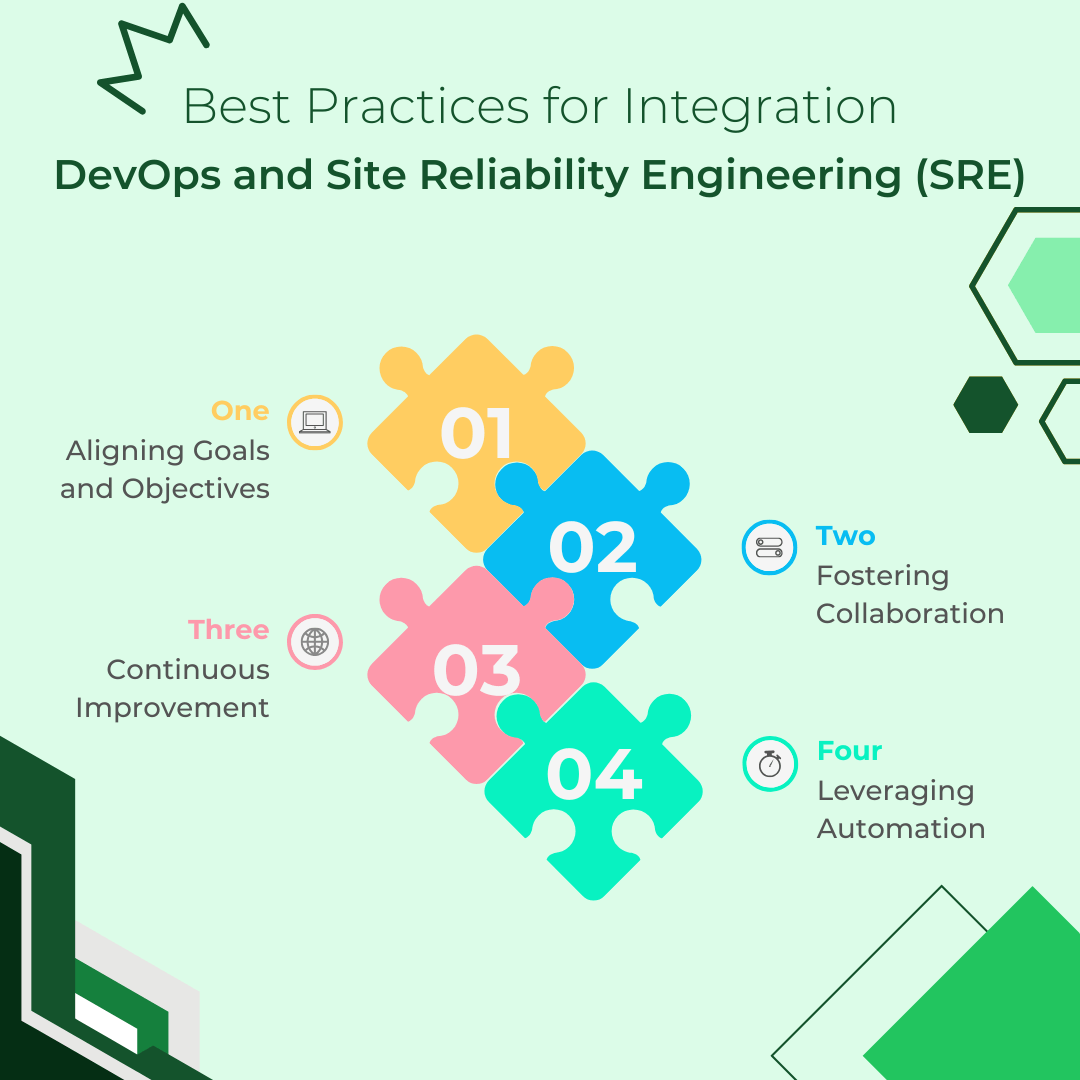Introduction
Organizations frequently face uncertainty about whether to implement DevOps, SRE, or both, leading to inefficiencies and missed opportunities. Misunderstanding their roles can undermine operational success.
Clarifying how DevOps and SRE work together helps businesses optimize processes, improve collaboration, and tackle challenges effectively. This article explores how to harmonize these methodologies to achieve operational excellence.
Understanding DevOps
DevOps is a methodology that integrates development and operations to enhance collaboration, streamline workflows, and accelerate the delivery of software. At its core, DevOps emphasizes the importance of communication between development and IT operations teams, promoting a culture of shared responsibility for the end-to-end process of software delivery.
Core Principles: DevOps relies on foundational concepts like continuous integration (CI), continuous delivery (CD), and infrastructure as code (IaC). CI focuses on regularly merging code changes into a shared repository, enabling early identification of potential issues.
CD streamlines the deployment process, guaranteeing fast and dependable software releases. IaC allows teams to manage and provision infrastructure using code, improving consistency and reducing manual errors.
Benefits: Adopting DevOps practices leads to faster deployment cycles, enabling businesses to respond quickly to market changes and customer needs. Enhanced collaboration between development and operations teams fosters a culture of shared responsibility and transparency, which contributes to higher quality and reliability of software.
Additionally, DevOps practices improve the overall efficiency of development processes, reducing time-to-market and increasing competitive advantage.
Challenges: Despite its advantages, implementing DevOps can present challenges. Organizations may face difficulties in overcoming cultural resistance, as transitioning to a DevOps mindset often requires significant changes in team dynamics and workflows.
Additionally, the complexity of integrating new tools and practices can be daunting for teams accustomed to traditional development methodologies. Successful DevOps adoption requires careful planning, ongoing training, and a commitment to fostering a collaborative environment.
Understanding SRE (Site Reliability Engineering)
Site Reliability Engineering (SRE) is a discipline that applies software engineering principles to operations and infrastructure management, focusing on improving system reliability and performance. Developed by Google, SRE aims to bridge the gap between development and operations by emphasizing engineering solutions to operational problems.
Core Principles: SRE revolves around a few key principles, including Service Level Objectives (SLOs), Service Level Agreements (SLAs), and Service Level Indicators (SLIs). SLOs define target reliability metrics for services, such as uptime or response time, while SLAs are formal agreements with customers regarding service performance.
SLIs are the measurements used to assess service reliability and ensure that SLOs are met. By setting clear reliability goals and monitoring performance, SRE helps organizations maintain high service quality.
Benefits: Implementing SRE practices enhances system reliability and uptime by proactively identifying and addressing potential issues before they impact users. SRE's focus on engineering solutions allows for more effective problem-solving and root cause analysis, leading to improved overall system performance.
Additionally, SRE practices help align operational goals with business objectives, ensuring that reliability efforts support broader organizational priorities.
Challenges: While SRE offers numerous advantages, it also presents challenges. The role requires deep technical expertise and a strong understanding of both software engineering and operational concerns.
This can make it challenging for organizations to find or develop qualified SRE professionals. Furthermore, implementing SRE practices can be complex, requiring significant changes to existing processes and tooling. Successful adoption of SRE demands a commitment to continuous learning, adaptation, and integration of best practices.
Comparing DevOps and SRE
DevOps and Site Reliability Engineering (SRE) are both methodologies aimed at improving software delivery and operational efficiency, but they focus on different aspects and approaches. Understanding their core objectives and methodologies helps organizations determine how best to leverage each or integrate them effectively.
Core Objectives: DevOps primarily focuses on enhancing collaboration and communication between development and operations teams to accelerate software delivery and deployment. It aims to break down silos, enabling faster and more reliable releases through practices like continuous integration and continuous delivery.
In contrast, SRE centers on maintaining and improving the reliability and performance of services. It sets and measures reliability goals using Service Level Objectives (SLOs) and Service Level Indicators (SLIs), and it prioritizes engineering solutions to address operational issues.
Approach and Methodology: DevOps practices emphasize automation and iterative improvements across the software development lifecycle. Essential practices include implementing automated testing, using deployment pipelines, and adopting infrastructure as code.
These practices aim to streamline processes and reduce manual intervention. On the other hand, SRE employs a more structured approach to reliability, focusing on metrics-driven management and incident response. SRE teams use tools and techniques to measure system performance and ensure adherence to reliability targets, often employing advanced monitoring and alerting systems.
Team Structures: DevOps teams are typically cross-functional, combining members from development, operations, and quality assurance to collaborate on the end-to-end process of software delivery.
In contrast, SRE teams are often specialized, with a strong focus on systems engineering and operations. They work closely with development teams but primarily concentrate on maintaining service reliability and performance.
DevOps and SRE: Understanding Their Relationship
The relationship between DevOps and Site Reliability Engineering (SRE) is often debated, with some viewing them as competing methodologies while others see them as complementary approaches. Understanding their interplay is crucial for organizations aiming to optimize their operations.
Synergies Between DevOps and SRE: DevOps and SRE can work together harmoniously to enhance overall performance. DevOps focuses on speeding up development and deployment processes, fostering collaboration between teams, and automating workflows. SRE, meanwhile, ensures that systems are reliable and meet performance goals by implementing metrics-driven approaches and engineering solutions.
Integrating these methodologies allows for a balanced approach where DevOps accelerates delivery while SRE maintains high reliability standards. Successful implementations, such as those seen in companies like Google and Netflix, demonstrate that combining DevOps and SRE practices can lead to improved efficiency, faster problem resolution, and better alignment with business objectives.
Potential Conflicts: Despite their potential for synergy, DevOps and SRE can sometimes have conflicting priorities. DevOps teams may prioritize speed and frequent releases, which could potentially compromise system stability if not managed carefully. Conversely, SRE focuses on maintaining reliability and may resist rapid changes that could introduce risks.
To manage these conflicts, organizations must establish clear communication channels and align on common goals. Balancing the need for speed with the imperative of reliability requires ongoing collaboration and a shared understanding of each methodology's objectives.
Strategies for Integration: To effectively integrate DevOps and SRE, organizations should set shared goals and metrics that align with both methodologies.
Encouraging open communication between teams and fostering a culture of collaboration can help address conflicts and ensure that both speed and reliability are achieved. Implementing regular feedback loops and iterative improvements also helps in refining processes and achieving optimal outcomes.
Case Studies
Examining real-world implementations of DevOps and Site Reliability Engineering (SRE) provides valuable insights into how these methodologies can be effectively integrated to achieve operational success. Here are some illustrative examples:
1. Google: As a pioneer in SRE, Google has successfully integrated these practices into its operations to enhance system reliability and performance. By setting clear Service Level Objectives (SLOs) and leveraging extensive monitoring and automation tools, Google ensures high availability and performance across its services.
The integration of SRE with DevOps practices has allowed Google to maintain rapid deployment cycles while keeping system reliability at the forefront. This synergy has led to improved user satisfaction and operational efficiency.
2. Netflix: Netflix is another example of successful DevOps and SRE integration. Netflix employs DevOps practices to enable rapid development and deployment of new features, utilizing continuous delivery pipelines and microservices architecture.
Simultaneously, its SRE teams focus on ensuring that these services are reliable and performant, using comprehensive monitoring and incident management systems. Netflix’s approach demonstrates how combining DevOps and SRE practices can support frequent releases without sacrificing service stability, allowing the company to quickly respond to user needs while maintaining high system reliability.
3. Etsy: Etsy, known for its e-commerce platform, has adopted DevOps practices to enhance collaboration between development and operations teams. By automating testing and deployment processes, Etsy has achieved faster release cycles and improved software quality.
In parallel, Etsy’s SRE team works to maintain service reliability and performance, focusing on metrics and incident response. This integration has helped Etsy achieve a balance between rapid innovation and system stability, leading to a more agile and resilient platform.
Best Practices for Integration
Integrating DevOps and Site Reliability Engineering (SRE) can drive significant improvements in software delivery and system reliability. To achieve a successful integration, organizations should follow these best practices:
1. Aligning Goals and Objectives: Establishing clear, shared goals between DevOps and SRE teams is essential. Both methodologies should work towards common objectives, such as enhancing customer satisfaction and optimizing operational efficiency.
Setting joint metrics and Service Level Objectives (SLOs) can ensure that both teams are aligned and focused on achieving these targets. This alignment helps prevent conflicting priorities and fosters a unified approach to both development speed and system reliability.
2. Fostering Collaboration: Encouraging open communication and collaboration between DevOps and SRE teams is crucial for successful integration. Regular cross-functional meetings and collaborative planning sessions can help teams understand each other’s goals and challenges.
Tools such as shared dashboards and integrated incident management systems can facilitate real-time collaboration and information sharing. Building a culture of mutual respect and shared responsibility helps bridge gaps and enhances team cohesion.
3. Continuous Improvement: Integration should be an ongoing process, with a focus on continuous improvement. Implementing feedback loops allows teams to evaluate their performance, identify areas for improvement, and make iterative adjustments.
Regularly reviewing processes, metrics, and outcomes helps teams refine their practices and adapt to evolving needs. Embracing a mindset of continuous learning and adaptation ensures that both DevOps and SRE practices evolve in tandem to meet organizational goals.
4. Leveraging Automation: Both DevOps and SRE benefit from automation, which can streamline workflows and reduce manual errors. Automating deployment pipelines, infrastructure management, and monitoring processes can enhance efficiency and reliability.
Integrating automation tools across both methodologies ensures that teams can deploy changes quickly while maintaining high standards of reliability and performance.

Future Trends and Developments
The fields of DevOps and Site Reliability Engineering (SRE) are evolving rapidly, driven by technological advancements and changing business needs. Understanding future trends and developments can help organizations stay ahead and adapt to emerging challenges.
Evolving Roles and Technologies: As technology continues to advance, the roles within DevOps and SRE are likely to evolve. The rise of artificial intelligence (AI) and machine learning (ML) is expected to impact both methodologies, with AI-driven tools enhancing automation, predictive analytics, and anomaly detection.
These technologies will enable more proactive management of systems, allowing for faster identification and resolution of issues. Additionally, the growing adoption of microservices and serverless architectures will require DevOps and SRE teams to adapt their practices and tools to manage increasingly complex and distributed systems.
Emerging Practices and Tools: The DevOps and SRE landscapes are witnessing the emergence of new practices and tools designed to enhance efficiency and reliability. For instance, chaos engineering is gaining traction as a method to test system resilience by deliberately introducing failures and observing system responses.
This practice helps teams identify weaknesses and improve their reliability strategies. In addition, new observability tools and platforms are being developed to provide deeper insights into system performance and user experiences, supporting more effective monitoring and incident management.
Increased Focus on Security: Security is becoming a central concern in both DevOps and SRE practices. As organizations continue to embrace digital transformation, integrating security into the development and operations processes is essential.
Practices such as DevSecOps are emerging to embed security measures throughout the development lifecycle, ensuring that security vulnerabilities are addressed proactively.
Key Takeaways
- DevOps and SRE Roles: DevOps focuses on speeding up software delivery through collaboration and automation, while SRE emphasizes system reliability and performance using metrics-driven approaches.
- Complementary Practices: Integrating DevOps and SRE can enhance both development speed and system stability, balancing rapid deployment with high reliability.
- Best Practices for Integration: Align goals, foster collaboration, embrace continuous improvement, and leverage automation to effectively combine DevOps and SRE practices.
- Future Trends: Emerging technologies like AI and ML, new practices such as chaos engineering, and increased focus on security are shaping the future of DevOps and SRE.
- Real-World Examples: Successful implementations by companies like Google, Netflix, and Etsy demonstrate the benefits of combining DevOps and SRE to improve efficiency and reliability.
Conclusion
DevOps and SRE serve distinct but complementary roles—DevOps focuses on speeding up software delivery, while SRE ensures system reliability. Integrating both can lead to faster deployments and more stable systems. By aligning goals, fostering collaboration, and embracing automation, organizations can balance speed with reliability.
As new technologies and practices emerge, staying adaptable will be key to maintaining operational excellence. Embracing the synergy between DevOps and SRE ensures optimal outcomes and aligns software delivery with business objectives.

